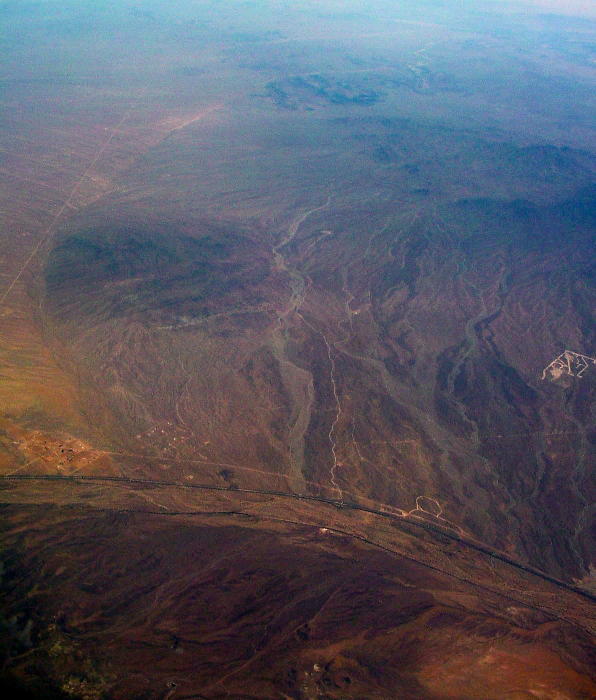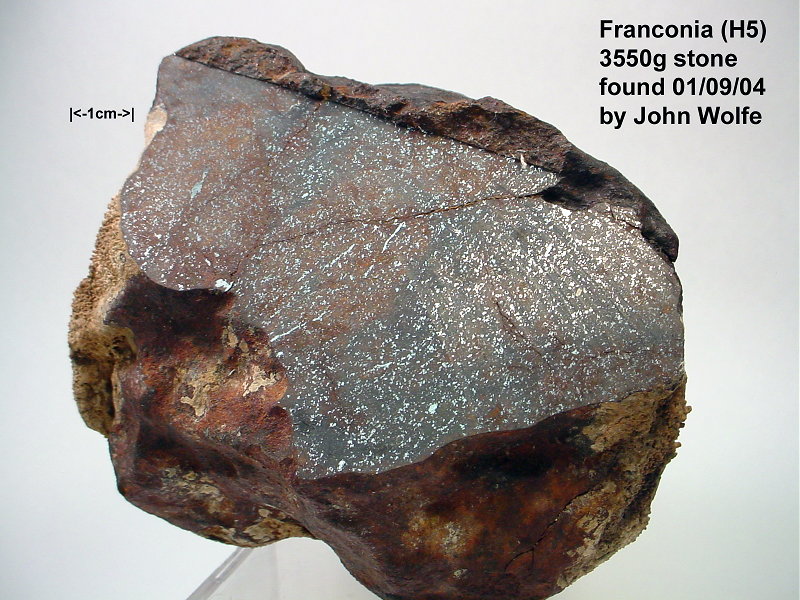![]()
"Franconia - Before the Gold Rush"
A reprint of my May 2004 article in the magazine titled, "Meteorite"

This aerial view of Franconia Wash was taken by the author from 22,000 ft in May 2009.
The view is south across the Sacramento Wash towards the Buck Mountains
and is looking down the trend of the Franconia strewn field(?s?).
--------------------------
by Robert S. Verish
There’s a “gold rush” going on right now in
The
This article will focus on the events before the
2004 Tucson Show. Prior to that time,
there were only a handful of people searching and documenting their efforts at
If meteorites
have fallen evenly over the surface of the Earth, then you may be asking, “Why
does
I need
to comment here - I realize that when meteorites impact the ground they usually
bury themselves. But nearly all of the
The
first reported find of the Franconia (H5) meteorite was in 2002 on October
31st. And my involvement with this
meteorite started that same day when the finder, John P. Wolfe, put in a phone
call to notify me of his latest find. Within
3 days I, along with a couple members of my meteorite recovery team, were in
the Franconia Wash inspecting the recovery site.
It’s
not that I had any doubts about John Wolfe’s find; it’s just that this is what
I do in my spare time. I document meteorites. And I study
the surfaces that they were found on. (A quick search on Google for “
I first
became acquainted with John, a gold-prospector-turned-meteorite-finder (with an
uncanny ability to find new meteorites), a year earlier back at Gold Basin when
I helped him get classified his 3.6kg fresh-fusion-crusted L6 meteorite that he
had found in the middle of that strewn field.
I have
often traveled through
Not
sure why John would regularly camp at
As
noted earlier, John got me involved immediately, and the next day he and a few
of his fellow gold prospectors started searching for more stones. My team members joined forces with them and a
meteorite-recovery alliance was formed!
But as
each week went by without a second find being made, we eventually became
discouraged. The reason we became discouraged is that even with a 6-man
recovery team, not enough area was getting covered. The slow pace was at the
heart of the problem. Because John and
his fellow prospectors were experts in the use of metal detectors at
Summer
comes early in the
These
advancements were more cultural than technological. And as a direct parallel, just as the Clovis
point simultaneously appeared in the archeological record at numerous sites
across the Americas, so too has the idea of searching for meteorites while
riding on an ATV now become a widespread practice this past hunting season. In short, most prospectors are now using ATVs
to search for meteorites.
John continued
to return to the
Had
this “second” stone not been lying next to the dirt road, there is no telling
how much longer it would have taken to find the
And
within the next 3 months, the vast majority of the stones from this strewn
field were found. In addition, at least 3 other “different” meteorites (still
pending classification) were found interspersed, or “over-lapping” this
Franconia (H5) strewn field. Hence, whenever
someone says that they found a
2
The importance of
finding the second stone may have been overstated, because the primary factor
for the rapid rate of recovery for the remaining stones is that nearly every
prospector is now hunting for meteorites while driving on an ATV!
But
this “advance” has come with a “down-side”.
The ATV’s can have a negative effect on the desert environment. And just
as the arrival of early-man to the
[Disclaimer: Neither I, nor any
Some
meteorite recovery lessons learned and observations from
1) The bad news is that the time and effort
needed to determine whether or not a strewn field exists may be greater than anticipated.
In the case of
2) The
good news is that since it has been shown that finds can be spotted while
operating an off-road vehicle, a greater area can be searched in a shorter time
period. In the case of
3) The bad news is that concentrated usage of
ATVs can have a negative impact on the desert environment.
Prior to February 2004 a total of 20
chondritic stones have been reported and documented (see Table). Of these, 10 have been verified as being
stones from the Franconia (H5) strewn field. The other 10 stones appear to be
from 2 or 3 different falls. They are
still pending classification. I have made available the data that I have
accumulated to the labs conducting the classifications by publishing the Table
included in this article.
Since
|
Name - |
Mass |
Found |
Pcs. |
GPS |
Finder |
Holder |
|
Field ID# |
(g) |
mm/dd/yy |
|
|
|
|
|
|
4255.0 |
|
1 |
r |
John Wolfe |
r (α) |
|
F 002 |
57.0 |
|
3 |
n/a |
Mike Miller |
r (β) |
|
F003-F008 |
33.0 |
|
5 |
n/a |
Rubin Garcia |
finder |
|
F 009 |
3550.0 |
|
1 |
r |
John Wolfe |
r |
|
F 010 |
~3000 |
|
1 |
r |
anonymous |
b.m. |
|
F 011 |
3430.0 |
|
1 |
r |
John Wolfe |
r |
|
F 012 |
1850.0 |
|
1 |
r |
Jim LaBarbera |
finder |
|
F 013 |
1653.3 |
|
1 |
r |
John Wolfe |
r |
|
F 014 |
650.0 |
|
14 |
r |
John Wolfe |
r |
|
F 015 |
~150 |
|
~5 |
r |
anonymous |
r |
|
F 016 |
456.3 |
|
1 |
r |
John Wolfe |
r |
|
F 017 |
16 lbs. |
|
1 * |
n/a |
anonymous |
finder |
|
F 018 |
816.0 |
|
1 |
r |
Larry Sloan |
r |
|
F 019 |
6750.0 |
|
1 |
r |
John Wolfe |
r |
|
F 020 |
817.0 |
|
1 |
r |
Larry Sloan |
r (β) |
|
|
|
? |
|
|
|
|
|
? =After this point in time, the date of finds
becomes uncertain, and |
||||||
|
only the
number of stones and the total mass was |
|
|||||
|
properly
recorded and is known for certain. |
|
|||||
|
There were
64 additional stones known to have been found, and |
||||||
|
as of |
||||||
|
Some of
those "later" stones that were of importance: |
|
|||||
|
|
|
|
|
|
|
|
|
F 021 |
6963.0 |
~02/06/2004 |
1 |
n/a |
J. Schrader |
r |
|
F 022 |
~2000 |
~02/15/04 |
1 * |
n/a |
"Homer" |
r |
|
F023-F029 |
~8500 |
Feb-Mar04 |
~10 |
n/a |
S. Clary |
finder |
|
F030-F033 |
14612 |
Feb-Mar04 |
4 |
n/a |
John Wolfe |
finder |
|
F034-F041 |
5975 |
Feb-Mar04 |
7 |
n/a |
John Wolfe |
finder |
|
F041-F054 |
4526 |
Feb-Mar04 |
13 |
n/a |
John Wolfe |
finder |
|
F 055 |
3787.5 |
~03/13/04 |
1 |
n/a |
property owner |
finder |
|
|
|
|
|
|
|
|
|
1 * = these two stones are not paired to Franconia
(H5), but they are |
||||||
|
most
likely paired to each other! |
|
|
|
|||
|
(α) = type specimen at UCLA |
|
|
|
|
||
|
(β) = type specimen at ASU |
|
|
|
|
||
|
b.m. = anonymous collector |
|
|
|
|
||
|
n/a = not available |
|
|
|
|
|
|
|
r = recorded & available upon request |
|
|
|
|||
|
|
|
|
|
|
|
|


Metzger, D. G. and Loeltz, O.
J., 1973, Geohydrology of the Needles area,
Roberts, P., 1992, Miocene Basin Evolution in the
upper plate of the Whipple detachment fault, southwestern
Spencer, J. E. and Patchett, P.
J., 1997, Sr isotope evidence for a lacustrine
origin for the upper Miocene Pliocene Bouse Formation, lower
R. Tweed,
Master's Thesis
...
SJ, eds., Geology and mineral resources of the Buckskin and Rawhide Mountains,
west-central
Arizona: Arizona Geological Survey Bulletin 198, p. 47-50. Buck,
WR ...
www.lowell.edu/users/tweedr/thes_ref.html - 19k -
Geologic
Map of the Mojave Mountains Area, Mojave County, Western ...
...
2 of sheet 1). The low Buck
Mountains lie northeast ... is
geopubs.wr.usgs.gov/i-map/i2308/

GEOLOGIC
MAP OF THE MOHAVE MOUNTAINS AREA, MOHAVE COUNTY, WESTERN ARIZONA, by K.A.
Howard, J.E. Nielson, H.G. Wilshire, J.K. Nakata, J.W. Goodge, S.L. Reneau, B.E. John, and V.L. Hansen, in U.S.G.S. Miscellaneous
Investigations Series I-2308, 1999

Aerial Photo from:
GEOLOGIC
MAP OF THE MOHAVE MOUNTAINS AREA, MOHAVE COUNTY, WESTERN ARIZONA, by K.A.
Howard, J.E. Nielson, H.G. Wilshire, J.K. Nakata, J.W. Goodge, S.L. Reneau, B.E. John, and V.L. Hansen, in U.S.G.S. Miscellaneous
Investigations Series I-2308, 1999
My previous articles can be found *HERE*
For for more information, please contact me by email:
Bolide*chaser
